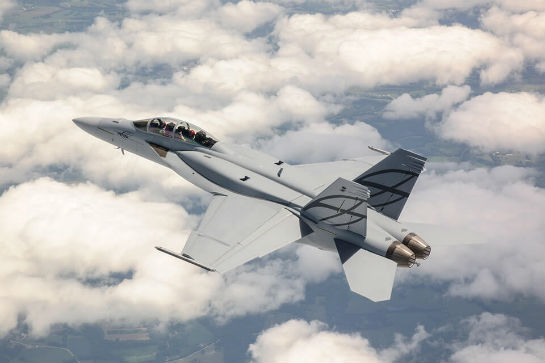The Boeing F/A-18 Super Hornet is a possible two-engine solution as the Royal Canadian Air Force contemplates its next generation of fighters. Boeing Photo
Ricardo Traven, chief test pilot on the Boeing F/A-18 Super Hornet, brings an obvious bias to the table when the question arises about how many engines Royal Canadian Air Force fighters should have.
Super Hornets, like the RCAF’s current fleet of “legacy” CF-188 Hornets, have two engines. Critics of its main rival for the next generation of RCAF fighters say the single-engine Lockheed Martin F-35 Lightning II is unsuitable for long-range missions into regions such as the Arctic despite the improved reliability of modern turbines.
During a Boeing briefing May 26 at CANSEC 2016, the annual trade show organized by the Canadian Association of Defence and Security Industries, Traven, a former CF-188 pilot who has flown dozens of other types during his career, offered a potentially persuasive argument for having more than one engine.
In his mid-20s at the time, he had left Goose Bay, Labrador, on a flight to Europe to participate in a North Atlantic Treaty Organization (NATO) exercise. Some 790 miles out and flying over “a whole lot of icebergs,” he lost one engine. He was equidistant from his takeoff point and the two only other viable options, runways in Greenland and Iceland. “It was the worst spot; Murphy’s law will always guarantee that,” he said.
So, down on power and unable to maintain a fuel-efficient altitude on one engine, he managed to refuel without incident from an accompanying tanker and returned safely to Goose Bay.
The memory of that mission is something Traven, who has evolved into a high-profile marketing asset for Boeing, is willing to share as the Canadian government continues to ponder its options for replacing the CF-188. That decision now seems likely to be put off until 2019 because the government has essentially rebooted the procurement process due to ongoing questions about the F-35’s operational maturity in its home market.
Traven acknowledged that there “absolutely” have been improvements in engines, but it would be “ridiculous” to suggest that failures don’t still happen, whether through a technological problem or foreign object damage (FOD) such as a bird strike or ice ingestion. While the newest engines can “catastrophically blow up and fail . . . the numbers are so rare that they’re almost not worth discussing.”
Nevertheless, the possibility of FOD, a hydraulic or fuel line crack, a maintenance oversight or even a single bullet in combat remained, but Traven said “we’re not talking about the reliability of the engine itself” because the core remains intact. “It’s everything else that makes the engine run.”
Traven also addressed the “stealth” issue, a key feature in Canada’s early decision in 1997 to be involved in the multinational Joint Strike Fighter development program which yielded the F-35. Critics of the Super Hornet say that it is easier to detect with radar than the F-35, but the Boeing pilot dismissed that argument.
“The Super Hornet is far stealthier than people know,” he said, adding that going into details would require access to classified briefings. But stealth was only one element of what pilots look for in aircraft survivability. “In the end, all we want to do is go on a mission and come back.” Stealth was a key factor but so, too, were the Super Hornet’s radar, electronic countermeasures and, again, its twin-engine configuration.

